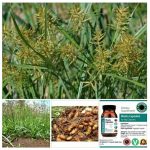Cyperus rotundus Linn. (Botanical name) or Coco-grass, Nut grass, Nutsedge, Sweet cyperus, Purple nut grass (English) or Àyaà-áyaà, Giragiri, Girigiri, Gwaigwaya, Jigi, Jiji (Hausa) or Ayaare (Fula-Fulfulde) or Nû (Kanuri) or Ishọhọ i toho (Tiv): A useful perennial grass-like plant
DESCRIPTION AND OCCURRENCE
Nut grass is a perennial grass-like plant usually growing 10-30 cm tall, but sometimes to 75 cm. The plant spreads rapidly at the roots. The plant is a noxious weed of cultivation and waste places. In East Africa, it has become particularly serious in some irrigation schemes and in coffee grown under minimal tillage. Dispersal is principally by abundant seeding. The plant provides some grazing for stock, though not for horses, and it is said that the seed will pass through animals’ intestines undigested and ready to germinate. Active rhizome growth promotes further local spread. Cyperus rotundus is thought to originate from Africa. Now, it is widely distributed throughout the warmer parts of the world and it is very common all over South-East Asia.
Health/medicinal benefits of Nut grass
USES: Since very ancient times the bitter tasting and aromatic tubers have been collected from wild populations for human food as well as for medicinal and aromatic purposes in the eastern and southern Mediterranean area to China. In India it is used as important Ayurvedic drug and as insect repellent. In recent time in Korea and Vietnam cultivated as medicinal and aromatic plant, formerly also occasionally in temperate areas in gardens as medicinal plant.
The tuber of the Ayaa-ayaa plant can be eaten raw or cooked. A very strong flavour when freshly harvested and it is said to resemble ‘Vick’s VapoRub’, the tubers become milder if they are allowed to dry. A pleasant nutty flavour according to another report, but, another says that the roots are very unpalatable raw and a little better but still not very palatable when cooked. In Mali, the tubers are taken as an aphrodisiac.
The dried roots can be ground into a powder and used as a cereal. The seeds are regarded as famine food, used when all else fails. It is very small and would be fiddly (difficult) to use. The dried roots can be ground into a powder and used as a cereal. Nut grass is a pungent bitter-sweet herb that relieves spasms and pain, acting mainly on the digestive system and uterus.
The roots and tubers are analgesic, antibacterial, antispasmodic, antitussive (prevent or relieve cough), aromatic, astringent, carminative (relieving flatulence), diaphoretic (causing too much sweating), diuretic (increasing urine production), emmenagogue (stimulating or increasing menstrual flow), litholytic (ability to dissolve kidney stones), sedative, skin, stimulant, stomach ache, tonic and vermifuge (killing of intestinal worms).
They are used internally in the treatment of digestive problems and menstrual complaints. They are commonly combined with black pepper (Piper nigrum) in the treatment of stomachaches. The roots are harvested in the summer or winter and are dried for later use. An essential oil in the tubers has antibiotic activity and has been shown to arrest the growth of Micrococcus pyrogenes.
The plant is rated 8th amongst 250 potential antifertility plants in China. The plant is used in the treatment of cervical cancer. In Jebel Marra of India, the tubers are crushed and made into a scented ointment with ghee, and in West Africa, they are used to perfume clothing and to repel insects. The leaves are used in basketry and for weaving hats, matting etc.
The aromatic root is used for perfumery in India. When dried and ground into a fine powder it is used like talcum powder. The plant is known to contain sesquiterpene lactones.
Studies of folk medicines implicate sesquiterpene lactones as the active ingredient in many treatments for other ailments such as diarrhea, burns, influenza, and neurodegradation. In addition to the anti-inflammatory response, sesquiterpene lactones have been found to sensitize tumor cells to conventional drug treatments.

Some sesquiterpenoid lactones are antimicrobial, disrupting the cell wall of fungi and invasive bacteria, whereas others protect the plant from environmental stresses that would otherwise cause oxidative damage. In the future, Cyperus rotundus may become very important as animal feed, food and beverage as well as material and medicinal.
These are the thoughts of:
Sa’eed Halilu Bawa
Senior Lecturer (Associate Professor) at University of the West Indies, St. Augustine Campus, Trinidad.
Studied Food and Nutrition Sciences, Dietetics at Kaduna Polytechnic, Nigeria; Warsaw University of Life Sciences, Poland.
























